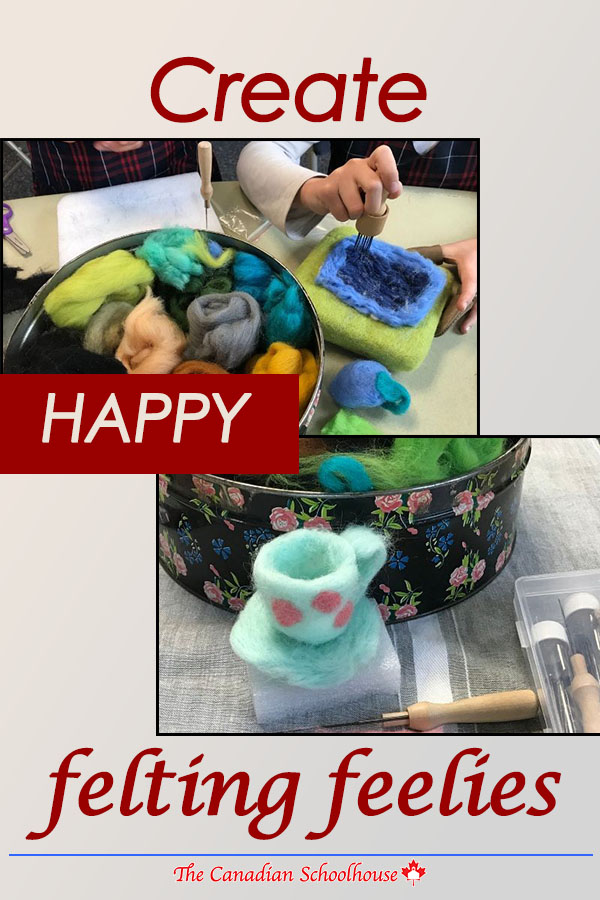
When I began teaching felting to seven- and eight-year-olds, I was curious to see if they could give steady, focused attention to the task. After all, felting requires much patience before any visible results are evident. As a Charlotte Mason-inspired educator, I believe that “attention is no more than this—the power of giving your mind to what you are about” (Charlotte Mason, vol.5, pg.29). Young children are not only capable of giving their minds to what they are about, but they are also eager to do it—especially when there is the promise of beautiful work and rich ideas to occupy their minds. Felting provides exactly that.
Here are some best practices for teaching felting to young children:
1.) Provide quality materials.
Providing quality materials for your beginners will lay a foundation for success that avoids false starts. Don’t fall into the trap of buying the cheapest. I did and wasted precious time and momentum. So, I’ve made the mistakes for you and can confidently tell you the four essential materials that you will need: merino wool, a multiple-needle awl, a 100-percent wool felting pad and finally leather (not silicone) finger protectors.
I’ve experimented with different types of wool and found merino’s colours and fine, soft texture to be most appealing. I also recommend white roving wool for any projects requiring a sturdy interior base. The first response to wool often has to do with how it feels. I laughed out loud when one young child exclaimed, “It’s so feelie!” Another child held several brightly coloured skeins in his hands and said, “These colours are zappin’ me in the head.”
2.) Teach the habit of attention.
Creating a peaceful environment evokes a child’s desire to work at something diligently and quietly. Put on some soft nature-inspired music (like woodland birds or ocean waves). Work by a window with lots of natural light pouring in. Train your children to use steady, rhythmic pokes that are neither too fast nor too slow. Even with leather finger protectors and quality materials, finger pricks are still possible—so encourage absolute focus. If there is quiet conversation, train children to speak while looking steadily at their project. If they must make eye contact, have them pause in their work.

3.) Choose beginner projects.
Nothing dampens the spirit like reaching too far too soon. Although your child may desire to felt a chickadee into existence, it’s better to begin with the basics in order to be prepared for the much-desired creation of little animals and objects. A great first project is a simple felted rectangle, with a flower or ladybug layered on top of it. Once this first project is completed, move on to creating a three-dimensional mushroom or perhaps a spotted snake. In this way, small hands will develop that knack for felting that produces beautifully executed work.
4.) Experience the history of felting.
Check out books from your local library about both felting and wool. It’s possible to create an entire unit about wool around the simple question, “What animals give us wool?” Find out if there are any sheep or alpaca farms near you and go on a field trip. Spend time exploring how wool is carded, coloured and turned into yarn or material. Discover how this industry began and what significance it may have had to your own ancestors. If you have a yarn shop near you, email them to ask if they sell felting materials or have felting classes. Often these shop owners have a plethora of knowledge to share with you. Some of them even get their wool from villages around the world in order to provide jobs for the global economy.
There’s so much more about felting to discover online. Spend time looking for new ideas and inspiration and then go ahead and create something beautiful. I hope you’ll enjoy it so much it will give you happy felting feelies.
 Joleen Steel is a Canadian who spent her summers at Arlington Beach, Saskatchewan. Joleen currently lives in Warrenville IL with her husband and youngest son. Joleen teaches kindergarten at a Charlotte Mason inspired Christian school. She writes for all three of The Old Schoolhouse Magazine publications and has published several short stories for children. Joleen is the executive director for www.campingstickkids.org. Go to her website to find out how you can hold camp in your own backyard!
Joleen Steel is a Canadian who spent her summers at Arlington Beach, Saskatchewan. Joleen currently lives in Warrenville IL with her husband and youngest son. Joleen teaches kindergarten at a Charlotte Mason inspired Christian school. She writes for all three of The Old Schoolhouse Magazine publications and has published several short stories for children. Joleen is the executive director for www.campingstickkids.org. Go to her website to find out how you can hold camp in your own backyard!





















